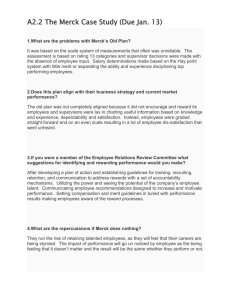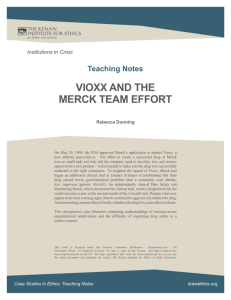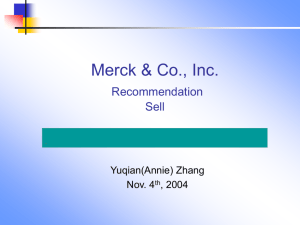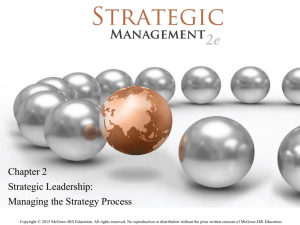The Vioxx Settlement: Salvation or Sell-Out? by Bruce Patsner, M.D., J.D.
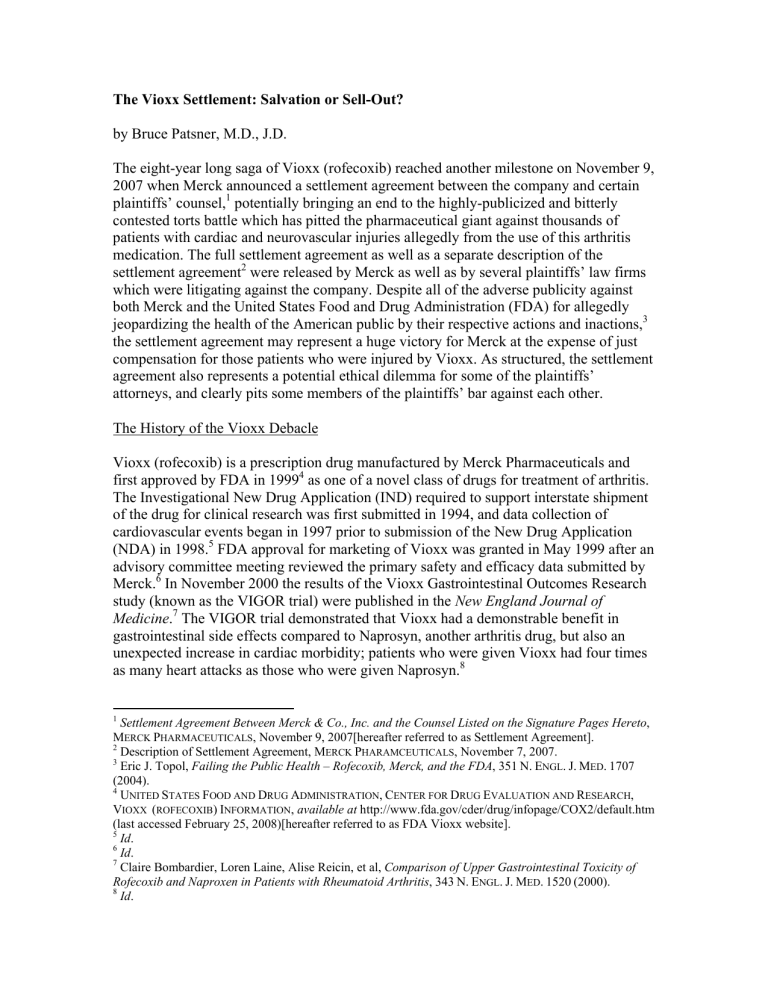
The Vioxx Settlement: Salvation or Sell-Out?
by Bruce Patsner, M.D., J.D.
The eight-year long saga of Vioxx (rofecoxib) reached another milestone on November 9,
2007 when Merck announced a settlement agreement between the company and certain plaintiffs’ counsel,
1
potentially bringing an end to the highly-publicized and bitterly contested torts battle which has pitted the pharmaceutical giant against thousands of patients with cardiac and neurovascular injuries allegedly from the use of this arthritis medication. The full settlement agreement as well as a separate description of the settlement agreement
2
were released by Merck as well as by several plaintiffs’ law firms which were litigating against the company. Despite all of the adverse publicity against both Merck and the United States Food and Drug Administration (FDA) for allegedly jeopardizing the health of the American public by their respective actions and inactions,
3 the settlement agreement may represent a huge victory for Merck at the expense of just compensation for those patients who were injured by Vioxx. As structured, the settlement agreement also represents a potential ethical dilemma for some of the plaintiffs’ attorneys, and clearly pits some members of the plaintiffs’ bar against each other.
The History of the Vioxx Debacle
Vioxx (rofecoxib) is a prescription drug manufactured by Merck Pharmaceuticals and first approved by FDA in 1999
4
as one of a novel class of drugs for treatment of arthritis.
The Investigational New Drug Application (IND) required to support interstate shipment of the drug for clinical research was first submitted in 1994, and data collection of cardiovascular events began in 1997 prior to submission of the New Drug Application
(NDA) in 1998.
5
FDA approval for marketing of Vioxx was granted in May 1999 after an advisory committee meeting reviewed the primary safety and efficacy data submitted by
Merck.
6
In November 2000 the results of the Vioxx Gastrointestinal Outcomes Research study (known as the VIGOR trial) were published in the New England Journal of
Medicine .
7
The VIGOR trial demonstrated that Vioxx had a demonstrable benefit in gastrointestinal side effects compared to Naprosyn, another arthritis drug, but also an unexpected increase in cardiac morbidity; patients who were given Vioxx had four times as many heart attacks as those who were given Naprosyn.
8
1
Settlement Agreement Between Merck & Co., Inc. and the Counsel Listed on the Signature Pages Hereto ,
2
M ERCK P HARMACEUTICALS , November 9, 2007[hereafter referred to as Settlement Agreement].
3
Description of Settlement Agreement, M ERCK P HARAMCEUTICALS , November 7, 2007.
Eric J. Topol, Failing the Public Health – Rofecoxib, Merck, and the FDA , 351 N.
E NGL .
J.
M ED .
1707
4
(2004).
U NITED S TATES F OOD AND D RUG A DMINISTRATION , C ENTER FOR D RUG E VALUATION AND R ESEARCH ,
V IOXX ( ROFECOXIB ) I NFORMATION , available at http://www.fda.gov/cder/drug/infopage/COX2/default.htm
5
(last accessed February 25, 2008)[hereafter referred to as FDA Vioxx website].
6
Id .
Id .
7
Claire Bombardier, Loren Laine, Alise Reicin, et al, Comparison of Upper Gastrointestinal Toxicity of
8
Rofecoxib and Naproxen in Patients with Rheumatoid Arthritis , 343 N.
E NGL .
J.
M ED .
1520 (2000).
Id .
This was the first signal that there was a potential major safety problem with Vioxx.
Despite this data, the drug was left on the market and, in no small part due to an aggressive direct to consumer advertising campaign,
9
soon became a blockbuster drug for
Merck with annual sales in the billions of dollars
10
and more than 10 million prescriptions written each month in the United States alone.
11
FDA did hold another advisory committee meeting on the VIGOR trial in February 2001, and voted unanimously that physicians should be made aware of the VIGOR study’s cardiac results.
12
More publications about the cardiac risks of Vioxx also appeared in the medical literature.
13
These events notwithstanding, Merck continued to downplay the cardiovascular morbidity in its direct to physician advertising.
14
Significant controversy also emerged surrounding the conduct of Merck and several of the authors of the VIGOR study; the editors of the New England Journal of Medicine noted that known additional cardiovascular morbidity data was intentionally omitted from the manuscript submitted to the Journal .
15
Internal memoranda from the Merck ultimately released also painted a more worrisome picture than that which was being presented to physicians and consumers.
16
It was only three years later in September 2004 when Merck completed longer-term followup of a second study (the APPROVe – Adenomatous Polyp PRevention On Vioxx
- clinical trial)
17
designed to demonstrate that Vioxx could prevent colon polyp formation that the cardiovascular events caused by Vioxx finally caught up with the company.
18
The APPROVe study was terminated early when a preliminary analysis showed an unequivocal increased relative risk of adverse cardiovascular events (e.g. heart attack and stroke) beginning after 18 months of Vioxx therapy. Based on this data and the availability of apparently safer alternatives, Merck voluntarily withdrew Vioxx from the
U.S. market on September 30, 2004. At the time Vioxx was withdrawn from the U.S. markets, tens of thousands of Americans had taken the drug, annual sales had topped 2.5
9
Henry A. Waxman, The Lessons of Vioxx – Drug Safety and Sales , 352 N.
E NGL .
J.
M ED .
2576 (2005).
10
Topol, supra note 3. A blockbuster drug is one with annual sales in the United States in excess of 1 billion dollars.
11
12
Id .
13
FDA Vioxx website, supra note 4.
Debabrata Mukherjee, Steven E. Nissen, and Eric J. Topol, Risk of Cardiovascular Events Associated with Selective COX-2 Inhibitors , 286 JAMA 954 (2001).
14
15
Waxman, supra note 9.
Gregory D. Curfman, Stephen Morrissey, and Jeffrey M. Drazen, Expression of Concern Reaffirmed , 354
N.
E NGL .
J.
M ED .
1193 (2006).
20 out of more than 2000 patients suffered heart attacks after taking Vioxx, not 17 as the article reported. However, the editors of the New England Journal did not mention that there is no statutory requirement for a pharmaceutical manufacturer to include the same data in an article submitted to a medical journal that it provides in the new drug application for a prescription drug which it submits to FDA for marketing approval.
16
17
Id .
Marvin A. Konstam, et al, Cardiovascular Thrombotic Events in Controlled, Clinical Trials of
Rofecoxib , 104 C
IRCULATION
2280 (2001).
18
DJ Graham, D Campen, R Hui et al, Risk of acute myocardial infarction and sudden cardiac death in patients treated with cyclo-oxygenase 2 selective and non-selective non-steroidal anti-inflammatory drugs: nested case-control study , 365 L ANCET 475 (2005).
billion dollars,
19
and more than twenty thousand lawsuits had been filed against Merck.
The Litigation, and the Structure of the Settlement
Faced with a virtual avalanche of lawsuits over Vioxx, Merck’s litigation strategy was to try each case individually. The strategy appeared to be working. At the time the settlement agreement was announced this past November, only 16 cases had been decided and only 4 of those decisions were not in Merck’s favor.
20
Merck had appealed all four losing decisions and at the time of this writing has yet to pay out a dime to any plaintiff, even in the first Vioxx trial in August 2005 in Brazoria County, Texas.
21
According to Texas Lawyer magazine, the proposed settlement was “hammered out during year-long secret negotiations”
22
between a team representing the defendants and a team of six plaintiffs’ attorneys representing either a large number of cases or who worked in states with many cases, particularly in the four coordinated multidistrict proceedings federal, Texas, New Jersey, and California, which collectively comprised more than 95 percent of all current Vioxx plaintiffs nationwide. Although many plaintiffs’ attorneys and petitioners were not part of the negotiated settlement, the impetus for the settlement appears to have come from a group of four federal judges who collectively controlled the majority of the pending cases.
23
As the settlement is structured, Merck appears to be a clear winner. The agreement calls for a total payout of $4.85 billion to settle upwards of 27,000 lawsuits, some of which certainly have merit and might have resulted in multi-million dollar settlements against the company had they gone to trial.
24
As Merck voluntarily pulled the drug from the market four years ago, statute of limitations laws will likely doom many future claims.
Under the terms of the proposed Settlement Agreement, Merck saves an estimated 20-25 billion dollars in potential litigation costs, puts the entire product liability mess behind it,
19
Matthew Herper, Merck Withdraws Vioxx , F ORBES , September 30, 2004, available at http://www.forbes.com/2003/09/30/cx_mh_0930merck_print.html (last accessed February 25, 2008).
20
Mark Donald, Plaintiffs Counsel Disagree Over Ethical Duties in Vioxx Settlement , 23 T EXAS L AWYER
2007 (November 19, 2007).
21
The Lanier Law Firm, Pharmaceutical Liability Litigation at the Lanier Law Firm , available at http://www.lanierlawfirm.com/legal_practice_areas/pharmaceutical_liability/index.htm (last accessed
February 20, 2008). The jury verdict of $234.4 million in the Carol A. Ernst v. Merck & Co., Inc. trial, the first Vioxx trial in the nation, was reduced to $26.1 million plus interest by 23 rd
District Judge Ben Hardin of Brazoria County, and immediately appealed by Merck.
22
23
Donald, supra note 18.
Joe Nocera, Forget Fair; It’s Litigation As Usual , T HE N EW Y ORK T IMES , November 17, 2002 at B1.
“Over the last year, Merck had gained the upper hand. It was winning most of the cases, as juries bought into its arguments that there was simply no proof that Vioxx had caused the plaintiffs’ heart attacks. And the plaintiffs’ lawyers, who had invested upwards of $100 million developing the litigation and had yet to receive a penny, were on the run. So why, then, did Merck settle? Because it had no choice. The four judges managing most of the cases had decided that the time had come to settle the litigation, and Merck was not in a position to say no to the judges. If Merck had continued to fight, the judges could have piled on so many trials that the company would have been begging for mercy. Besides, Merck had won enough cases that it felt that it could devise a settlement that it could live with.”
24
Daniel Fisher, Will the Vioxx Settlement Work?, F ORBES November 13, 2007. Merck’s stock jumped when the $4.85 billion deal was announced.
closes out most future actions, and most importantly controls who gets paid and how the payment is structured.
25
The agreement contains a very carefully structured settlement structure which omits everything except two types of injuries
26
and requires that plaintiffs pass through several
“gates” to determine their eligibility. Plaintiffs must first provide definitive evidence of heart attack or ischemic stroke, prove both that they had received at least 30 Vioxx pills, and that they took at least one of the pills within 14 days of injury.
27
More importantly,
Merck also controls the “panel” of attorneys who will review the claims against the company, thus placing it in the position of deciding both the merit, and relative merit, of the claim as well as whether payment will be in full or proportional.
28
The latter is important because the degree to which injuries may be compensated is based on a points system over which Merck also exercises a great deal of control.
29
All of these features appear to distinguish this agreement from that negotiated in 1999 by
Wyeth in the fen-phen cases. In that litigation “pliant doctors could ‘diagnose’ injuries that in many cases didn’t occur or weren’t attributable to the product in question,”
30
and some plaintiffs were able to opt out of the settlement resulting in payouts that ultimately totaled more than $21 billion
31
instead of the planned $3.75 billion. Clearly, with Vioxx, not all plaintiffs with similar injuries are going to be equally compensated, some alleged injuries will not be compensated at all, and a determined attempt will be made to place a hard ceiling on the final monetary amount. Even so, those plaintiffs with the most clearcut cardiovascular injuries stand to get the most money.
32
Problems with the Settlement Agreement: Ethical Dilemnas for Attorneys?
The Settlement Agreement is not such a clear winner for all members of the plaintiffs’ bar either. The Agreement contains several unique provisions which directly impact on the attorney-client relationship in potentially negative ways; although some attorneys may make a great deal of money, some will only make money potentially at the expense of other clients. The Settlement Agreement carries a provision which aims to pressure as many people to settle now and to prevent lawyers from holding back on their strongest cases to bring at a later date.
33
For instance, the Agreement “requires any lawyer who participates in the Vioxx settlement to recommend it to all his clients who qualify – and to take legal steps to drop any clients who decline.”
34
It further prohibits attorneys who
25
Settlement Agreement, supra note 1.
26
Id . The only two types of injuries which potentially could be compensated are heart attack and stroke.
27
Id .
28
Id .
29
Id.
30
Fisher, supra note 22.
31
Heather Won Tesoriero and Nathan Koppel, Vioxx Settlement Plan Heads for Key Deadlines , W ALL
S
TREET
J
OURNAL
, January 10, 2008, at B1.
32
Settlement Agreement, supra note 1.
33
Id .
34
Tesoriero and Koppel, supra note 32.
settle from taking any other Vioxx cases.
35
Not surprisingly, these provisions of the
Settlement Agreement are facing legal challenge. In Texas, for example, these provisions appear to violate attorney ethics laws.
36
Some experts on legal ethics have been even more direct: “The law is clear” says Professor Linda S. Eads at Southern Methodist
University Dedman School of Law. “When you withdraw from a case because your client does not want to take the settlement that is the equivalent of abandoning your client. We are not permitted to abandon clients in Texas.”
37
Where Things Stand Now
It’s been almost 6 months since the agreement was announced. The registration deadline of January 15 th
for lawyers to register all of the estimated 60,800 Vioxx cases has already passed.
38
By February 29 th
, 85% of the eligible cases must have enrolled for the settlement to move forward.
39
April 14, 2008 is the earliest deadline by which Merck can walk away from the deal, and July 1, 2008 the final deadline for all plaintiffs to have submitted all materials needed for their respective claims.
40
Is it possible that additional suits will be brought against Merck for alleged Vioxx-related injuries at a later date, even if the Settlement Agreement is signed and delivered? Yes. If you can find an attorney willing to take the case.
Health Law Perspectives (February 2008), available at: http://www.law.uh.edu/healthlaw/perspectives/homepage.asp.
35
Settlement Agreement, supra note 1.
36
T EXAS D ISCIPLINARY R ULES OF P ROFESSIONAL C ONDUCT R.
5.06 provides that a “lawyer shall not participate in offering or making (b) an agreement in which a restriction on the lawyer’s right to practice is part of the settlement of a suit or controversy,” available at www.texasbar.com/Content/Management/Content/Display.cfm?ContentID=13942 (last accessed February
26, 2008).
37
Donald, supra note 20.
38
Settlement Agreement, supra note 1
39
Id.
40
Id .

